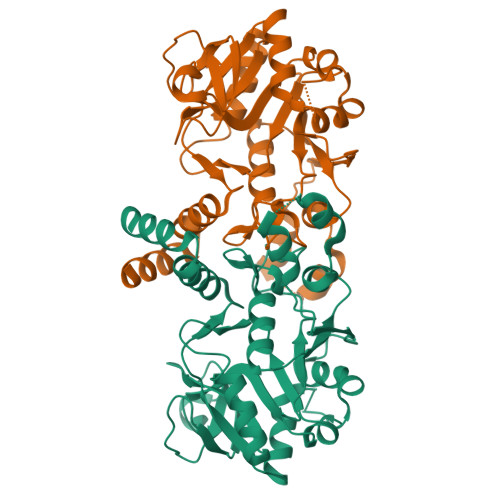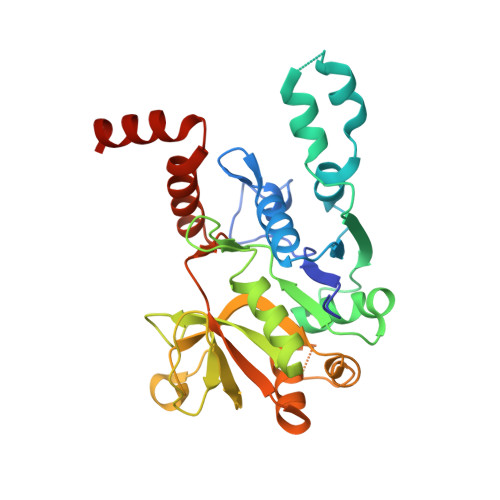Glucose-1-phosphate uridylyltransferase from Erwinia amylovora: Activity, structure and substrate specificity.
Benini, S., Toccafondi, M., Rejzek, M., Musiani, F., Wagstaff, B.A., Wuerges, J., Cianci, M., Field, R.A.(2017) Biochim Biophys Acta 1865: 1348-1357
- PubMed: 28844747
- DOI: https://doi.org/10.1016/j.bbapap.2017.08.015
- Primary Citation of Related Structures:
4D48 - PubMed Abstract:
Erwinia amylovora, a Gram-negative plant pathogen, is the causal agent of Fire Blight, a contagious necrotic disease affecting plants belonging to the Rosaceae family, including apple and pear. E. amylovora is highly virulent and capable of rapid dissemination in orchards; effective control methods are still lacking. One of its most important pathogenicity factors is the exopolysaccharide amylovoran. Amylovoran is a branched polymer made by the repetition of units mainly composed of galactose, with some residues of glucose, glucuronic acid and pyruvate. E. amylovora glucose-1-phosphate uridylyltransferase (UDP-glucose pyrophosphorylase, EC 2.7.7.9) has a key role in amylovoran biosynthesis. This enzyme catalyses the production of UDP-glucose from glucose-1-phosphate and UTP, which the epimerase GalE converts into UDP-galactose, the main building block of amylovoran. We determined EaGalU kinetic parameters and substrate specificity with a range of sugar 1-phosphates. At time point 120min the enzyme catalysed conversion of the sugar 1-phosphate into the corresponding UDP-sugar reached 74% for N-acetyl-α-d-glucosamine 1-phosphate, 28% for α-d-galactose 1-phosphate, 0% for α-d-galactosamine 1-phosphate, 100% for α-d-xylose 1-phosphate, 100% for α-d-glucosamine 1-phosphate, 70% for α-d-mannose 1-phosphate, and 0% for α-d-galacturonic acid 1-phosphate. To explain our results we obtained the crystal structure of EaGalU and augmented our study by docking the different sugar 1-phosphates into EaGalU active site, providing both reliable models for substrate binding and enzyme specificity, and a rationale that explains the different activity of EaGalU on the sugar 1-phosphates used. These data demonstrate EaGalU potential as a biocatalyst for biotechnological purposes, as an alternative to the enzyme from Escherichia coli, besides playing an important role in E. amylovora pathogenicity.
Organizational Affiliation:
Bioorganic Chemistry and Bio-Crystallography laboratory (B2Cl), Faculty of Science and Technology, Free University of Bolzano, 39100 Bolzano, Italy. Electronic address: stefano.benini@unibz.it.
















